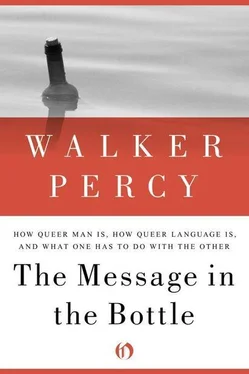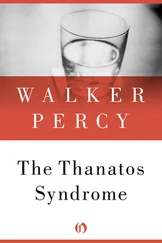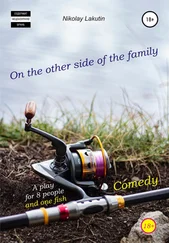Who is the Thou that gazes at me? Whoever he may be and despite the importunacy of his gaze and the need at any cost to come to terms with it. I know one thing about him — he is an existent. However successfully I may have been able to objectize him, when he looks at me, his being escapes through his eyes. As Marcel says, it is of the nature of the other that he exists.
The Sartrean elevation of nothingness as the prime reality of the human existent, the awarding of priority to existence over essence, is perhaps a confusion of the psychological and the ontological orders, a mistaking of human being for the predicament of consciousness. When Matthieu stops in the middle of Pont Neuf and discovers his freedom in his nothingness—“Within me there is nothing, not even a wisp of smoke; there is no within. There is nothing. I am free”—he is after all only hypostasizing the unformulability of self. The telltale sign is his elation, his sense of having at last discovered his identity. He is something after all — Nothing! And in so doing, is he not committing the same impersonation which Sartre so severely condemns in others? If the structure of consciousness is intentional, to be of its essence directed toward the other, a being-towards, then the ontologizing of this self-unformulability as Nought is as perverse as any other impersonation — really a kind of inferior totemism.
Yet even Sartrean existentialism can only be edifying to the empirical mind. For whatever the sins of bad faith of an existentialism which postulates atheism, it has been able to recover that which the empiricist in his obsessive quest for reducibility and quantification has lost — the uniqueness of human being.
Prescinding entirely from final ontological constructions as befits an empirical science, and approaching existential realities solely in the light of an empirical finding — the uniquely human symbolic transformation — a science of man can only prove true to itself by seeing the human existent for what, at its minimum reach, it really is — not a quantifiable integer, a receptable of biological needs and so susceptible to fixed inductions, but a transcending reality, and hence a reality which can be studied, not by an uncritical transposition of the method of physical science, but by a broad and untrammelled empiricism, a sensitivity and a neutrality before structures which will neither rule out nor preconceive causal connections for reason of doctrinal requirement.
AFTER READING FEELING AND FORM, Susanne Langer’s extraordinary work on aesthetics, one inevitably goes back to her earlier book Philosophy in a New Key, of which according to the author the former is the companion volume — not just to get one’s bearings in the general semiotic on which the aesthetic is based, but in all curiosity to trace out the origins of what is surely an ambiguity in the thought of the recent study. Feeling and Form is written with all the power and contagious excitement of first-class mind exercising a valuable new insight. In brief, it is an application to art of her general thesis that the peculiarly human response is that of symbolic transformation. The communication of meaning, positivists to the contrary, is not limited to the discursive symbol, word, and proposition; the art symbol conveys its own appropriate meaning, a meaning inaccessible to the discursive form. In each medium, the virtual space of the painting, the virtual life of the poem, the virtual time of music, the form which is created represents, symbolizes —not just the thousand and one subject matters of the various arts but rather the feelings, the felt life of the artist and so of the observer. Music symbolizes passage, “the form of growth and attenuation, flowing and stowing, conflict and resolution,” the pattern in time of sentience. (Here it is worth pointing out that the “feelings” that Mrs. Langer talks about are not at all feelings in the modern sense of the word, that is, “emotions,” amorphous affect, but rather the form of sentience, a notion which it would be interesting to compare with the Thomist concept of the tendential forms of orexis.)
Not the least remarkable thing in a remarkable book is how very close at times she comes to a Scholastic view of art, and that in a theorist with an otherwise encyclopedic grasp of her subject, there is not a single reference to Maritain or any other Scholastic source (not that this is surprising from the author of Philosophy in a New Key). This resemblance may be noted without in the least suggesting that her theory should be judged by a Scholastic standard of aesthetics, if indeed there is any such thing, or that she is approaching analogously “what the Schoolmen knew all along”—for the fact is that her contribution is in the highest degree original and potent in its unifying effect, and if any one thing is certain it is that she owes not the slightest debt to a Scholastic source. As we shall see, she has the most compelling of all reasons — one’s own philosophical presuppositions — for steering as far clear of Scholasticism as ever she can, and so it is all the more remarkable that from such a heroically disinterested source there should come forth
The making of the symbol is the musician’s entire problem, as it is, indeed, every artist’s.
That, whereas language is the discursive symbol, the word symbolizing the concept,
Art is the creation of forms symbolic of human feelings.
That is why [because it gives the forms of imagination] it has the force of a revelation and inspires a feeling of deep intellectual satisfaction, though it elicits no consciousness of intellectual work (reasoning).
And in protest against Croce’s equating “intellectual” and “discursive”:
But by contemplating intuition as direct experience, not mediated, not correlated to anything public, we cannot record or systematize them, let alone construct a “science” of intuitive knowledge which will be the true analogue of logic.
Compare with Maritain
The sphere of Making is the sphere of Art.
Art is above all intellectual.
Beauty is essentially the object of intelligence, for what knows in the full meaning of the word is the mind.
…it is mind and sense combined, the intellectualized sense which gives rise to aesthetic joy in the heart.
…the splendor or radiance of form glittering in the beautiful thing is not presented to the mind by a concept or an idea but precisely by a sensible object, intuitively apprehended.
The capital error in Benedetto Croce’s neo-Hegelian aesthetics…is the failure to perceive that artistic contemplation, however intuitive it may be, is none the less above all intellectual. Aesthetics ought to be intellectual and intuitivist at the same time.
Maritain is more explicit about the dual role of the art symbol in his latest work than in Art and Scholasticism.
Be it painting or poem, this work is made object — in it alone does poetic intuition come to objectivization. And it must always preserve its own consistence and value as object. But at the same time it is a sign — both a direct sign of secrets perceived in things, of some irrecusable truth of nature of adventure caught in the great universe, and a reversed sign of the subjective universe of the poet, of his substantial Self obscurely revealed.
A text from Thomas Aquinas is interesting in this connection:
Therefore beauty consists in proper proportion because the sense derives pleasure from things properly proportioned as being similar to itself for sense also is a kind of reason (logos tis) like every cognitive virtue and as knowledge comes about through assimilation and similtude is concerned with form, the beautiful strictly pertains to the concept of a formal cause.
Читать дальше












